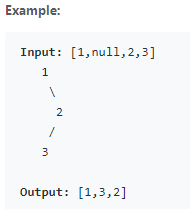medium
20. Valid Parentheses
Given a string containing just the characters ‘(’, ‘)’, ‘{’, ‘}’, ‘[’
and ‘]’, determine if the input string is valid.An input string is valid if:
Open brackets must be closed by the same type of brackets. Open
brackets must be closed in the correct order. Note that an empty
string is also considered valid.Example 1:
Input: “()” Output: true
Example 2:
Input: “()[]{}” Output: true
Example 3:
Input: “(]” Output: false
Example 4:
Input: “([)]” Output: false
Example 5:
Input: “{[]}” Output: true
Short java solution:
class Solution {
public boolean isValid(String s) {
Stack<Character> stack = new Stack<Character>();
for (char c : s.toCharArray()) {
if (c == '(')
stack.push(')');
else if (c == '{')
stack.push('}');
else if (c == '[')
stack.push(']');
else if (stack.isEmpty() || stack.pop() != c)
return false;
}
return stack.isEmpty();
}
}
155. Min Stack
Design a stack that supports push, pop, top, and retrieving the
minimum element in constant time.push(x) – Push element x onto stack.
pop() – Removes the element on top of the stack.
top() – Get the top element.
getMin() – Retrieve the minimum element in the stack.Example:
MinStack minStack = new MinStack();
minStack.push(-2);
minStack.push(0);
minStack.push(-3);
minStack.getMin(); --> Returns -3.
minStack.pop();
minStack.top(); --> Returns 0.
minStack.getMin(); --> Returns -2.
Share my Java solution with ONLY ONE stack:
The question is ask to construct One stack. So I am using one stack.
The idea is to store the gap between the min value and the current value;
The problem for my solution is the cast. I have no idea to avoid the cast. Since the possible gap between the current value and the min value could be Integer.MAX_VALUE-Integer.MIN_VALUE;
class MinStack {
/** initialize your data structure here. */
public class MinStack {
long min;
Stack<Long> stack;
public MinStack(){
stack=new Stack<>();
}
public void push(int x) {
if (stack.isEmpty()){
stack.push(0L);
min=x;
}else{
stack.push(x-min);//Could be negative if min value needs to change
if (x<min) min=x;
}
}
public void pop() {
if (stack.isEmpty()) return;
long pop=stack.pop();
if (pop<0) min=min-pop;//If negative, increase the min value
}
public int top() {
long top=stack.peek();
if (top>0){
return (int)(top+min);
}else{
return (int)(min);
}
}
public int getMin() {
return (int)min;
}
}
}
/**
* Your MinStack object will be instantiated and called as such:
* MinStack obj = new MinStack();
* obj.push(x);
* obj.pop();
* int param_3 = obj.top();
* int param_4 = obj.getMin();
*/
medium
94. Binary Tree Inorder Traversal
Given a binary tree, return the inorder traversal of its nodes’ values.
Follow up: Recursive solution is trivial, could you do it iteratively?
Iterative solution in Java - simple and readable:
/**
* Definition for a binary tree node.
* public class TreeNode {
* int val;
* TreeNode left;
* TreeNode right;
* TreeNode(int x) { val = x; }
* }
*/
class Solution {
public List<Integer> inorderTraversal(TreeNode root) {
List<Integer> list = new ArrayList<Integer>();
Stack<TreeNode> stack = new Stack<TreeNode>();
TreeNode cur = root;
while(cur!=null || !stack.empty()){
while(cur!=null){
stack.add(cur);
cur = cur.left;
}
cur = stack.pop();
list.add(cur.val);
cur = cur.right;
}
return list;
}
}
394. Decode String
Given an encoded string, return it’s decoded string.
The encoding rule is: k[encoded_string], where the encoded_string inside the square brackets is being repeated exactly k times. Note that k is guaranteed to be a positive integer.
You may assume that the input string is always valid; No extra white spaces, square brackets are well-formed, etc.
Furthermore, you may assume that the original data does not contain any digits and that digits are only for those repeat numbers, k. For example, there won’t be input like 3a or 2[4].
public class Solution {
public String decodeString(String s) {
String res = "";
Stack<Integer> countStack = new Stack<>();
Stack<String> resStack = new Stack<>();
int idx = 0;
while (idx < s.length()) {
if (Character.isDigit(s.charAt(idx))) {
int count = 0;
while (Character.isDigit(s.charAt(idx))) {
count = 10 * count + (s.charAt(idx) - '0');
idx++;
}
countStack.push(count);
}
else if (s.charAt(idx) == '[') {
resStack.push(res);
res = "";
idx++;
}
else if (s.charAt(idx) == ']') {
StringBuilder temp = new StringBuilder (resStack.pop());
int repeatTimes = countStack.pop();
for (int i = 0; i < repeatTimes; i++) {
temp.append(res);
}
res = temp.toString();
idx++;
}
else {
res += s.charAt(idx++);
}
}
return res;
}
}

